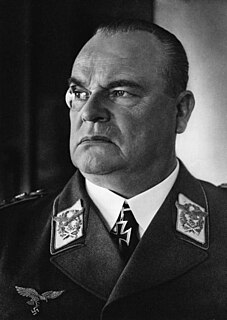
Wolfram Karl Ludwig Moritz Hermann Freiherr von Richthofen was a German World War I flying ace who rose to the rank of Generalfeldmarschall in the Luftwaffe during World War II.

Wilhelm Hugo Sperrle, also known as Hugo Sperrle, was a German military aviator in World War I and a Generalfeldmarschall in the Luftwaffe during World War II.

Between 1933 and 1945, the organization of the Luftwaffe underwent several changes. Originally, the German military high command, for their air warfare forces, decided to use an organizational structure similar to the army and navy, treating the aviation branch as a strategic weapon of war. Later on, during the period of rapid rearmament, the Luftwaffe was organized more in a geographical fashion.

Jagdgeschwader 5 was a German Luftwaffe fighter wing during World War II. It was created to operate in the far north of Europe, namely Norway, Scandinavia and northern parts of Finland, all nearest the Arctic Ocean, with Luftflotte 5, created specifically to be based in occupied Norway, and responsible for much of northern Norway.

Jagdgeschwader 77 Herz As was a Luftwaffe fighter wing during World War II. It served in all the German theaters of war, from Western Europe to the Eastern Front, and from the high north in Norway to the Mediterranean.
Jagdfliegerführer Norwegen was a formation of the German Luftwaffe based in Occupied Norway during World War II. It was named for the "Fighter Leader (Jafu), Norway" and referred to the units under his command.

Kampfgeschwader 3 "Blitz" was a Luftwaffe bomber wing during World War II.

Martin Harlinghausen was a German military aviator and general. Harlinghausen specialised in maritime interdiction and anti-warship operations. During World War II Harlinghausen was the leading exponent of anti-ship warfare with the destruction of 22 ships credited to him.
During the Second World War the German Luftwaffe was the main support weapon of the German Army (Heer). It fought and supported the Wehrmacht's war effort throughout the six years of conflict and contributed to much of Nazi Germany's early successes in 1939–1942. After the turn in Germany's fortunes, it continued to support the German ground forces until the German surrender in May 1945.
Zerstörergeschwader 76 was a Zerstörergeschwader (wing) of the German Luftwaffe during World War II. The wing operated the Messerschmitt Bf 109 in the early phases of World War II, then the Messerschmitt Bf 110 for the duration of the war.

Unternehmen Paula is the German codename given for the Second World War Luftwaffe offensive operation to destroy the remaining units of the Armée de l'Air (ALA), or French Air Force during the Battle of France in 1940. On 10 May the German armed forces (Wehrmacht) began their invasion of Western Europe. By 3 June, the British Army had withdrawn from Dunkirk and the continent in Operation Dynamo, the Netherlands and Belgium had surrendered and most of the formations of the French Army were disbanded or destroyed. To complete the defeat of France, the Germans undertook a second phase operation, Fall Rot, to conquer the remaining regions. In order to do this, air supremacy was required. The Luftwaffe was ordered to destroy the French Air Forces, while still providing support to the German Army.

X. Fliegerkorps was a formation of the German Luftwaffe in World War II, which specialised in coastal operations. It was formed 2 October 1939, in Hamburg from the 10. Flieger-Division.

Kampfgeschwader 26 "Löwengeschwader" was a German air force Luftwaffe bomber wing unit during World War II. Its units participated on all of the fronts in the European Theatre until the end of the war. It operated three of the major German aircraft medium bomber types; the Heinkel He 111, Junkers Ju 88 and the Junkers Ju 188. The unit engaged in both strategic bombing, close air support, anti-shipping and aerial interdiction operations. The majority of its operational life – not entirely unlike another Luftwaffe wing designated KG 40 — was spent on anti-shipping missions.

Sturzkampfgeschwader 1 was a Luftwaffe dive bomber wing during World War II.

Kampfgeschwader 1 was a German medium bomber wing that operated in the Luftwaffe during World War II.
Max Bucholz was a German Luftwaffe ace and recipient of the Knight's Cross of the Iron Cross during World War II. Bucholz was credited with between 28 and 30 victories, including an ace in a day.

This is the order of battle for Operation Barbarossa, the German invasion of the Soviet Union during World War II. It was fought between the German-led Axis Forces and the Soviet Forces. The operation started on June 22, 1941, and ended on December 5, 1941, at the conclusion of Operation Typhoon.

Axis and Soviet air operations during Operation Barbarossa took place over a six-month period, 22 June – December, 1941. Aviation played a critical role in the fighting on the Eastern Front during this period, in the battles to gain and maintain air superiority or air supremacy, to offer close air support to armies on battlefield, interdicting enemy supply lines, while supplying friendly forces. The Axis air forces were generally better equipped, trained and experienced in executing military tactics and operations. This superiority increased because of the Great Purge in the 1930s and mass expansion of Soviet air forces, which did severe damage to organisational structures.
The Luftnachrichten Abteilung 350, abbreviated as OKL/Ln Abt 350 and formerly called the, was the Signal Intelligence Agency of the German Air Force, the Luftwaffe, before and during World War II. Before November 1944, the unit was the Chiffrierstelle, Oberbefehlshaber der Luftwaffe, which was often abbreviated to Chi-Stelle/ObdL or more commonly Chi-Stelle.
Zerstörergeschwader 2 was a Luftwaffe heavy/destroyer Fighter Aircraft-wing of World War II.














